Lemony ramp pesto is an easy and delicious way to showcase ramps. Delicious with fish, chicken, or steak, as well as tossed with pasta.
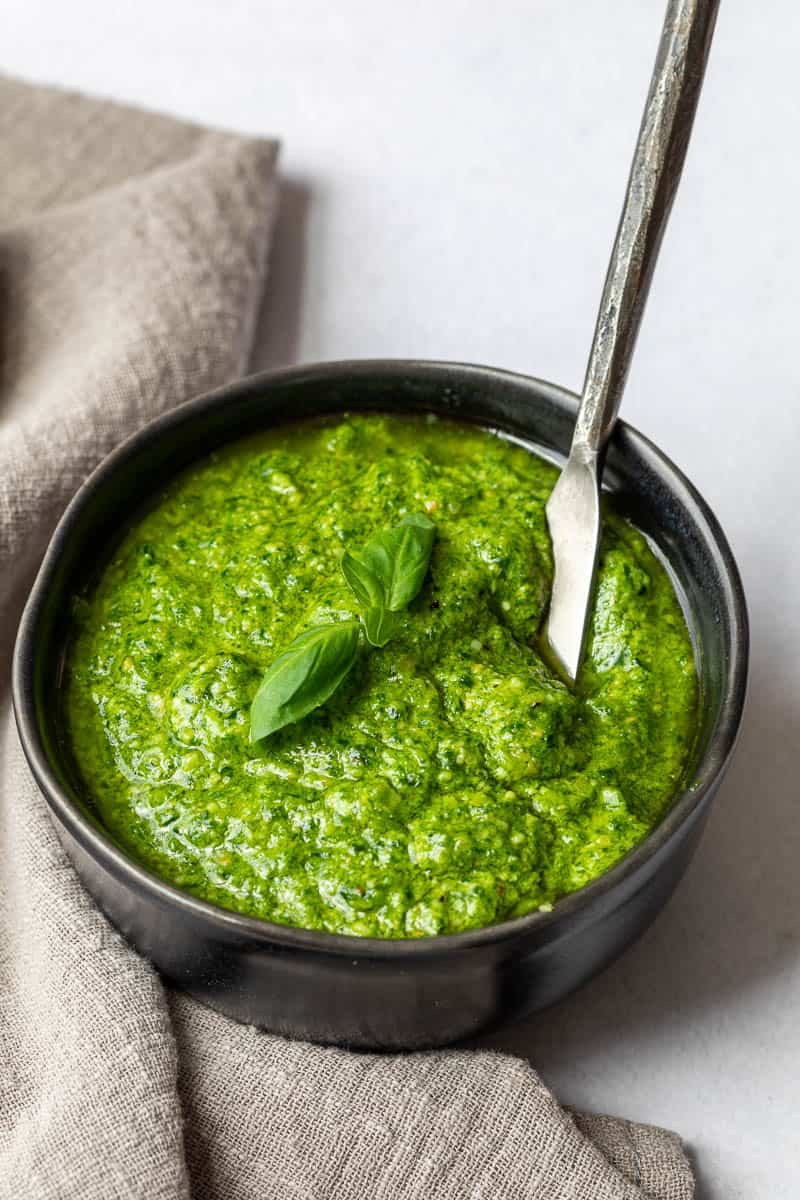
Ramp season is always a thrill. The number of weeks in which these beauties appear at the farmer’s market can be measured on one hand. And ramp devotees know to get there early because vendors often sell out. (Wild ramps should be sustainably harvested so as not to destroy future crops, so it’s a good sign if your vendor has only a small quantity.)
Once you have successfully found your ramps, you'll need to decide what to do with them. Ramps are delicious charred on a grill, roasted, or pickled, but ramp pesto is a classic.
Jump to:
Why Make This Recipe
- Delicious savory, garlicky flavor that pairs well with all sorts of ingredients
- So many uses for ramp pesto! Use it wherever you would use regular pesto.
- Easy to freeze so you can have a taste of spring whenever you want
🥗 Ingredients
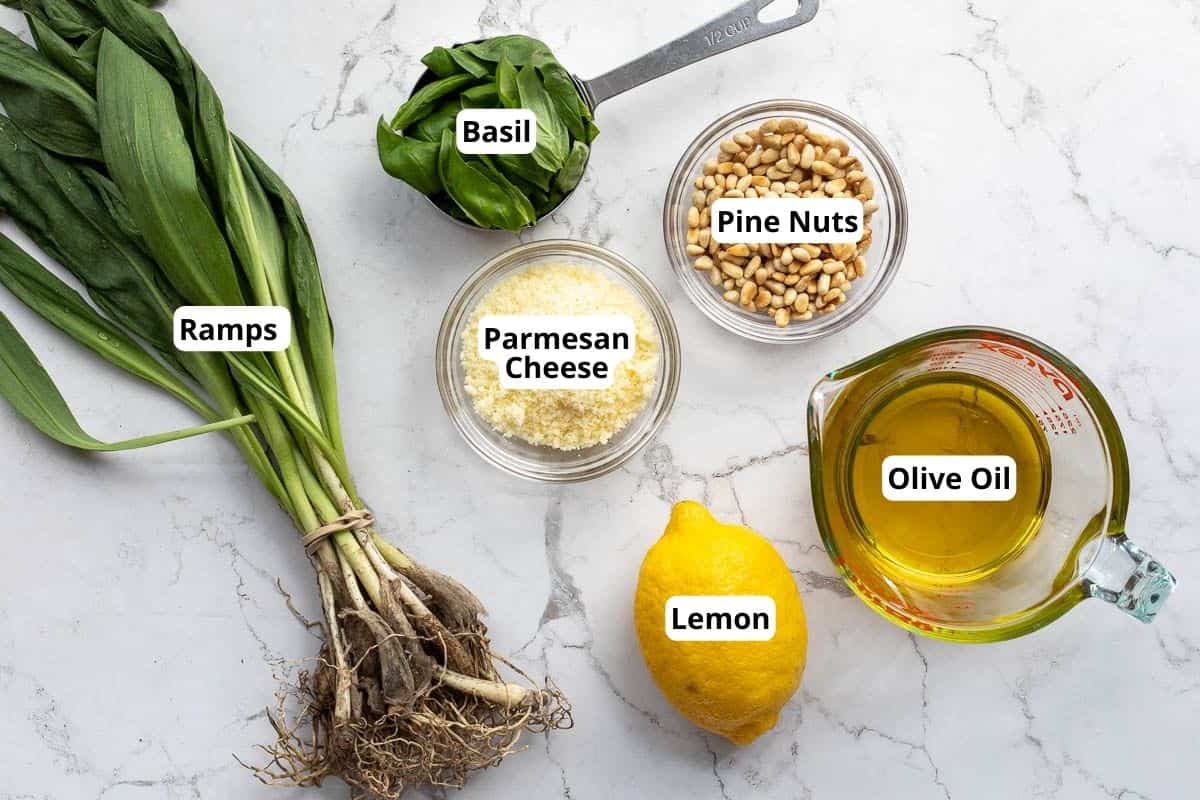
- Ramps: Look for ramps with fresh-looking leaves that aren't wilted. If you're looking for a similar recipe when ramps aren't in season, be sure to check out my Simple Lemon Basil Pesto recipe too.
- Pine Nuts: These nuts provide a nice creamy texture when ground up. But pesto is quite a flexible recipe, so feel free to replace them with walnuts or almonds. I’d recommend toasting whatever nut you choose.
- Parmesan cheese: for this recipe, I (gasp) use the packaged pre-grated parmesan cheese in the deli section of my supermarket. Grated, not shredded, is best, and do get the parm in the refrigerated section and not on the shelf of the spaghetti sauce section. I’m not sure what that is, but it’s not cheese.
- Lemon zest: You’ll want a microplane to zest your lemons. This tool, born as a wood lathe, is one of my favorite kitchen implements. When you use it to zest a lemon, lime, or orange, the zest comes off smoothly without tearing any of the bitter pith underneath.
- Olive oil: Use your favorite olive oil for this recipe, but no need to use a super expensive one. Any decent virgin olive oil will do just fine.
🥣 Step-by-Step Instructions
Trim the ends on a bunch of ramps, and rinse well. Pat dry. Then rinse ½ cup of fresh basil leaves and pat dry. Chop the ramps roughly in 1-2 inch pieces. You can use both the ramp leaves and stalks—you should have about 2 cups total.
Put in food processor along with ¼ cup toasted pine nuts, ¼ cup parmesan cheese, ⅓ cup olive oil, ½ teaspoon lemon zest, 1 tablespoon lemon juice, ½ teaspoon kosher salt, and ¼ teaspoon fresh ground black pepper.
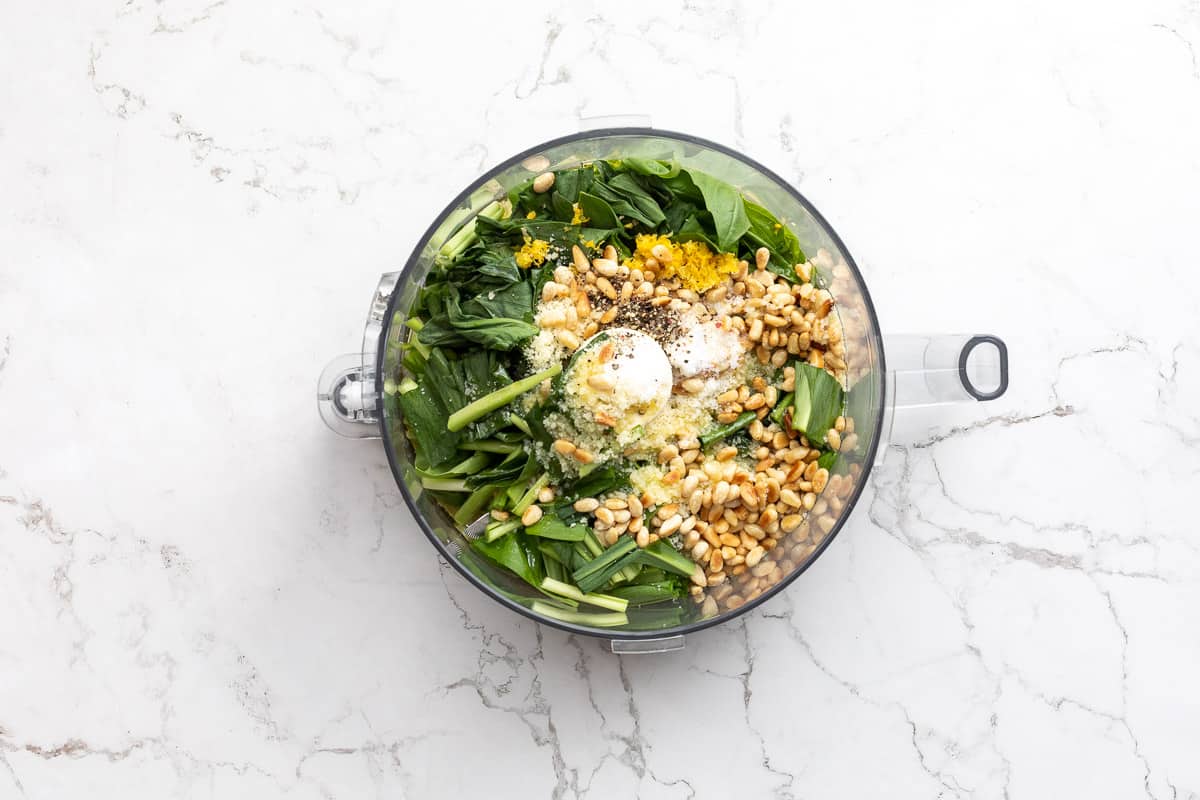
Blend until combined into a creamy pesto.
Taste and add an additional tablespoon of lemon juice if desired. Add more salt and pepper to taste.
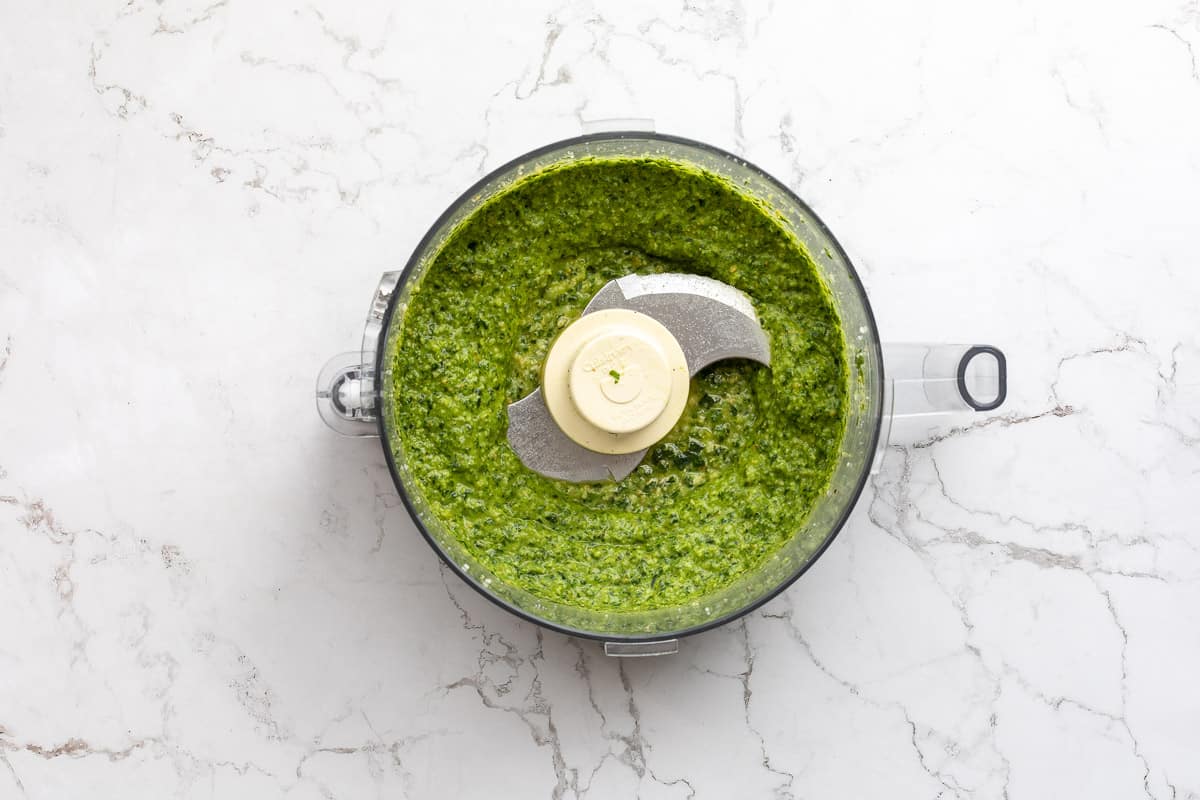
🧐 Recipe FAQs for Ramp Pesto
Ramps are wild plants that are related to leeks and shallots, but have a much sharper, garlicky flavor. They are coveted by chefs and foodies partly for their flavor, and partly for their scarcity. If you love ramps, you can only get them for a few weeks out of the year in late spring.
Yes, definitely! Use within 3 months for best flavor.
Ramp pesto will last in an airtight container in the refrigerator for up to a week. If you are worried about the pesto browning a little on top (like guacamole), just press a layer of plastic wrap on the top of the pesto.
👩🍳 Expert Tips
One of the great things about pesto is that you can really make it exactly as you like it. The quantities for almost all of the ingredients can be altered to your taste. Not a big lemon fan? Reduce the amount of lemon juice and/or omit the lemon zest. Prefer more pine nuts or cheese in your pesto? Add away. There are no wrong answers in pesto, so have courage.
Want the loveliest, most decadent pesto of all time? Buy a good hunk of Parmigiano-Reggiano and grate it yourself on your microplane. Real parmesan that you grate yourself is always better—however, in this case I do think the ramps and the pine nuts make it hard to discern the really good stuff, and using a microplane to grate a hunk of parm until you have ¼ cup, packed, takes dedication.
For even more protection against browning, consider blanching ramps. Bring a pot of water to boil, and throw in the ramps for 30-45 seconds. Then drain and plunge into a large bowl of ice water. The ice water will stop them from continuing to cook, but that short time in the boiling water will help them keep their bright green color after you have made them into pesto.
After draining out of the ice water, pat them as dry as possible with paper towels or a clean kitchen towel before chopping and adding to your food processor.
How to toast pine nuts: Pine nuts are easy to toast, but you must watch them carefully. My favorite method is to use a small skillet. Heat the skillet on medium-low, then add your pine nuts. WATCH THEM CAREFULLY.
I can’t tell you how many times I’ve had to throw out burned pine nuts because I walked away from the stove at the crucial time.
Resist the urge to turn the heat up to high—yes, that will toast your pine nuts faster, but they are likely to burn or at least will be very unevenly toasted. So, low and slow it is. Stir them around every 30 seconds or so on medium-low heat.
They will start to turn golden brown and smell toasty within a few minutes. When they do, take them off the heat immediately.
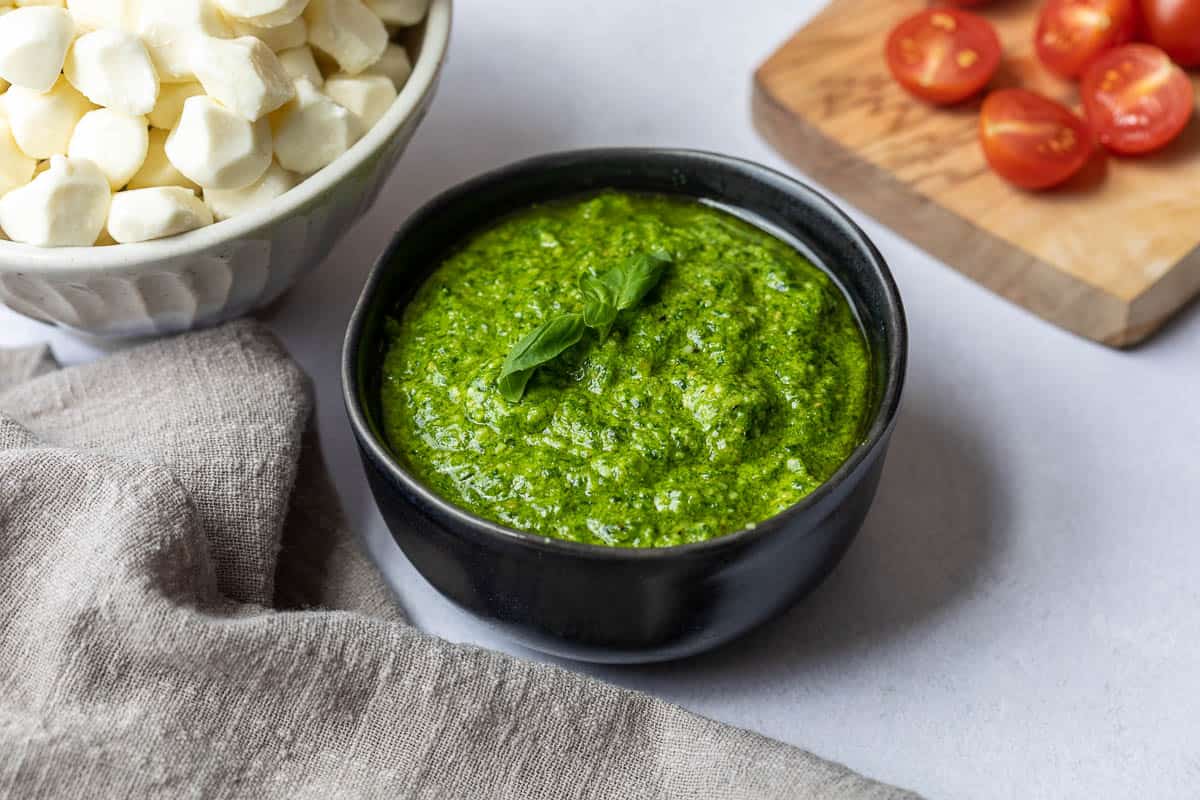
Uses for Ramp Pesto
Ramp pesto has so many different applications. Word of warning though, that garlicky ramp flavor is strong! There's a small bit of basil in my recipe to cut some of the sharpness, but if you are not a big fan of garlic, steer towards using your ramp pesto paired with some milder ingredients. That way, the flavors meld together deliciously. Here are some of my favorite uses for ramp pesto:
- Top crostini with ramp pesto, sliced tomatoes, and crumbled feta or fresh mozzarella cheese
- Toss with pasta or gnocchi
- Use as a dip for shrimp
- Serve on fish, chicken, or steak
- Toss with roasted potatoes or in potato salad
- Dollop on scrambled eggs
- Replace the regular pesto in this Pesto Orzo Salad recipe or this Pesto and Tuna Pasta recipe
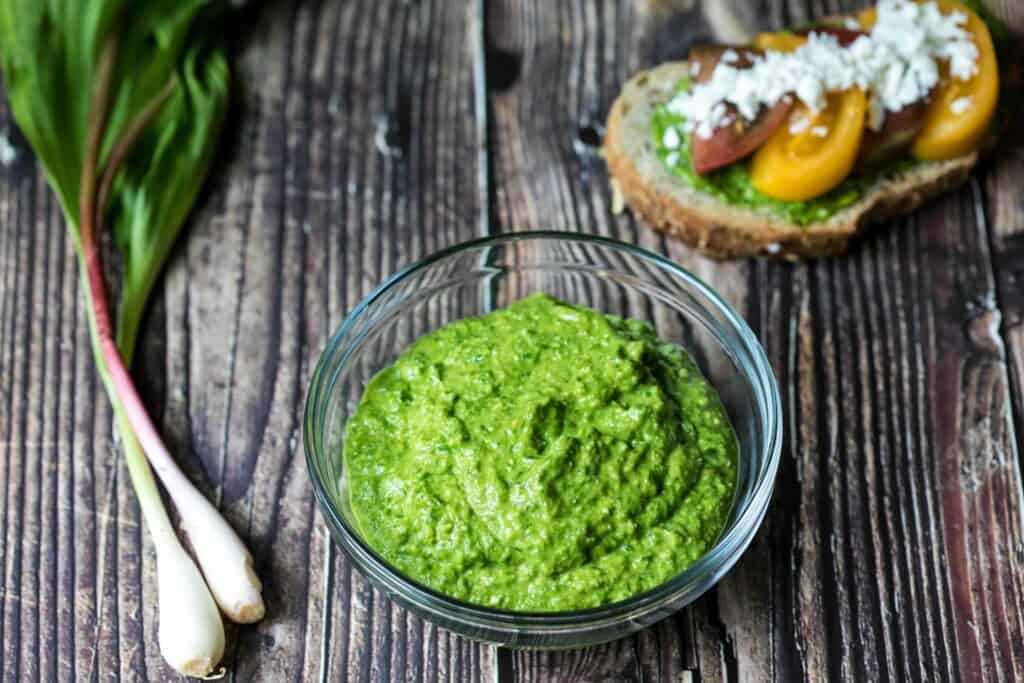
Other Delicious Spring Recipes
Ramps are only available for a short window in the spring. Want to make something else that takes full advantage of spring produce? Check out these recipes.
If you try this recipe, I would love to hear from you! Please rate this recipe and leave a comment below—your feedback is invaluable to me.
And please follow along on Instagram, Pinterest, and Facebook or subscribe to my newsletter. I’d love to inspire you with more delicious, healthy, and seasonal recipes!
Want to Save This Recipe?
Enter your email & I'll send it to your inbox. Plus, get great new recipes from me every week!
By submitting this form, you consent to receive emails from Vanilla Bean Cuisine.
📖 Recipe
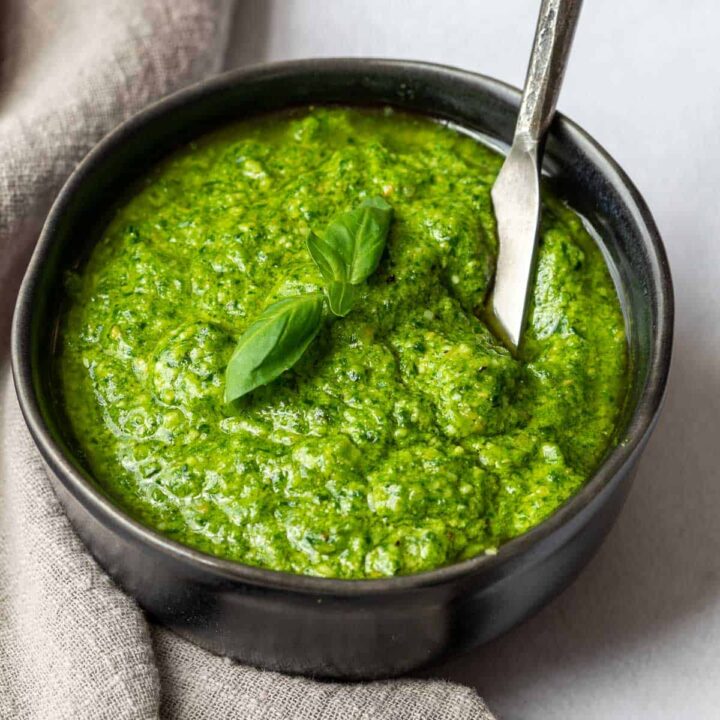
Lemony Ramp Pesto with Basil
Lemony ramp pesto is an easy and delicious way to showcase ramps. Delicious with fish, chicken, or steak, as well as tossed with pasta.
Ingredients
- 1 bunch of ramps, ends trimmed
- ½ cup fresh basil leaves
- ¼ cup pine nuts, toasted
- ¼ cup parmesan cheese
- ⅓ cup olive oil
- ½ teaspoon lemon zest
- 1-2 tablespoons lemon juice
- ½ teaspoon kosher salt
- ¼ teaspoon freshly ground black pepper
Instructions
- Rinse ramps and basil and pat dry, then chop roughly in 1-2 inch pieces. You can use both the ramp leaves and stalks—you should have about 2 cups total.
- Put in food processor along with pine nuts, parmesan cheese, olive oil, lemon zest, 1 T. lemon juice, salt, and pepper. Blend until combined into a creamy pesto.
- Taste and add additional tablespoon of lemon juice if desired. Add more salt and pepper to taste.
Notes
Store ramp pesto in an airtight container in the refrigerator for up to a week.
Ramp pesto can also be frozen for up to 3 months.
Keep in mind that the ramp stalks and bulbs are more potent than the leaves, so use more leaves vs. stalks if you want a less-garlicky pesto!
Recommended Products
As an Amazon Associate and member of other affiliate programs, I earn from qualifying purchases.
Nutrition Information:
Yield: 4 Serving Size: 1Amount Per Serving: Calories: 243Total Fat: 25gSaturated Fat: 4gTrans Fat: 0gUnsaturated Fat: 20gCholesterol: 5mgSodium: 273mgCarbohydrates: 3gFiber: 0gSugar: 0gProtein: 3g
Nutrition information is provided as a general reference for users courtesy of the online nutrition calculator Nutritionix.
Instagram Users: Now that you've made this recipe, tag me @vanillabeancuisine or #vanillabeancuisine because I’d love to see your results!








Leave a Reply